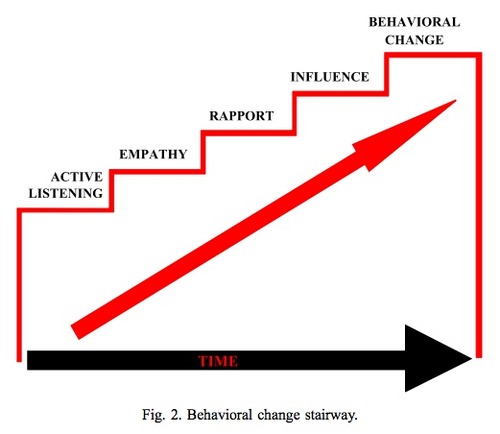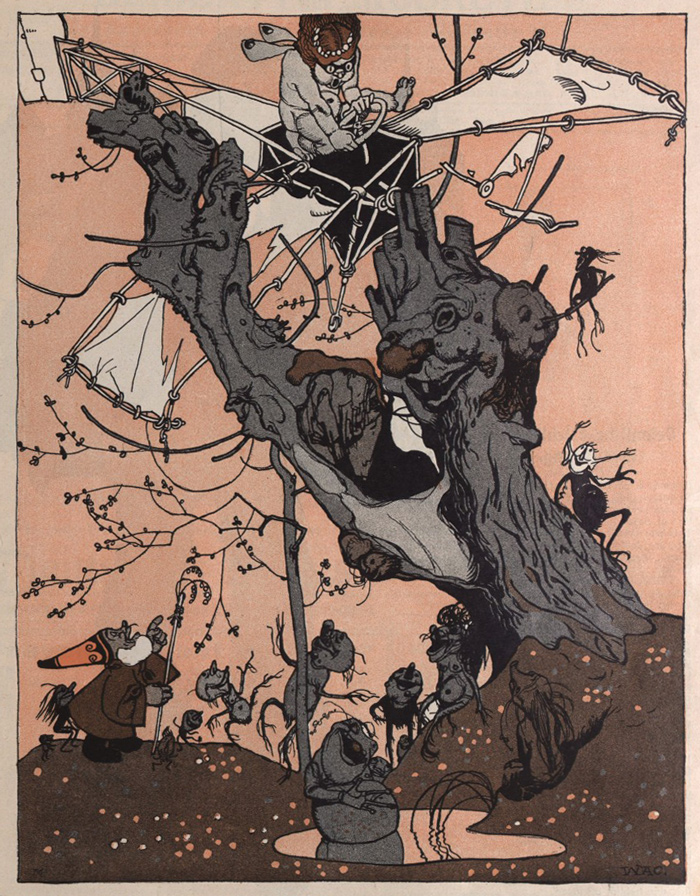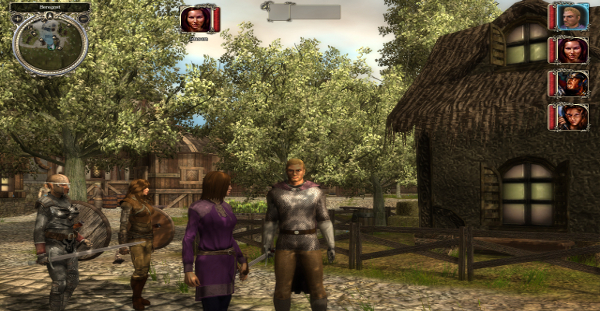
The way of the ninja requires massive sacrifices, and samurai must live by the exacting code of Bushido. Usually, pop culture depicts ninjas and samurai as stoic men — but here are 10 amazing women who rose to the challenge.

1) Tsukikage Ran
While women weren’t technically allowed to be samurai in feudal Japan, that didn’t stop Ran Tsukikage from grabbing a sword and wandering the countryside as a ronin in this action-comedy anime. The only thing she’s better at than swordplay is drinking sake, which she takes very seriously (do not spill good sake in front of her, or you will pay). Of course, this sake-habit means she’s often broke, and takes various jobs as a guard to make ends meet. That is, when she’s not just bumming off her friend Meow.

2) Miho, Sin City
Whether Miho is more of a samurai or a ninja or just an assassin is debatable. One thing she isn’t, though, is a prostitute — she just hangs out with the prostitutes of Old Town, and protects them from the many horrible horrible people that live in Sin City, almost solely by killing them violently. She’s quiet — she never speaks — and fast, thanks to her roller skates, and I’m pretty sure she’s kills every single man she interacts with in Frank Miller’s Sin City comics, with the sole exception of Dwight, who apparently saved her from a group of Tong gangsters in the past.

3) Tomoe Gozen
Although we don’t know for sure if Tomoe Gozen was a real historical figure or just a character in the Heike Monogatari, this female samurai was as beautiful as she was badass, and apparently she was quite beautiful. She was a “swordswoman worth a thousand,” and helped lead the general Minamoto no Yoshihara’s armies to victory over the Heike, taking more than a few of the enemy’s heads herself. Apparently she carried a massive, anime-esque sword, too. After the battle, she disappeared; some say she gave up the sword and became a nun, other than she married an enemy military commander.

4) Tsunade, Naruto
Although the characters of Naruto are technically called ninja, they’re actually much closer to bizarre superheroes than anything like what is traditionally considered a ninja. They don’t wear black, they rarely sneak around, and basically everything they do is outright magic. So when I say that Tsunade is the greatest female ninja in Naruto, I mean that she has the ability to summon a giant talking slug that can split into thousands of tiny slugs which can heal people by attaching to them. She’s also just as powerful a warrior as she is a medic; she’s strong enough to literally split the ground apart with a single finger poke. In addition, she’s the fifth Hokage, the leader of the Hidden Leaf Village, helped win the Second Shinobi World War, and despite being 50-years-old uses a special ninja technique to appear like a 20-something, and has a figure which pretty much prevents a truly safe Google Image Search for her.

5) Makie Otono-Tachibana, Blade of the Immortal
Trying to explain the insanely intricate plot of the Blade of the Immortal manga would take all day. The short version is that Makie was born into a samurai family, inherited her father’s skill with the sword, which caused her brother to commit suicide after discovering he could not beat her. In a series jam-packed with samurai and warriors, Makie is the top three, even beating out the protagonist Manji and the main antagonist Anotsu, whom Makie loves. Of course, she ends up dying from some lung disease, but she racked up an impressive body count before that, though.

6) Jinx, G.I. Joe
Thanks to the myriad G.I. Joe continuities, the origin of Jinx varies wildly, but she’s always been Joe’s best (and only) female ninja. She’s part of the Arashikage ninja clan that trained Snake Eyes, is definitely related to Storm Shadow, and was specifically trained by the Blind Master, meaning she can fight equally well in the dark or blindfolded. In Renegades she’s the daughter of the Hard Master, Snake Eyes’ teacher; in the Devil’s Due comics she had a romance with fellow martial artist Budo; in the original Marvel comics she’s part of Ninja Force; and somewhere she started a bounty hunting business. Still, she’s a damn fine ninja.

7) Jubei-chan the Ninja Girl
Jiyu Nanohana appears to be an ordinary schoolgirl, but she’s anything but. She’s the descendant of the legendary samurai Jubei Yagyu, and she she puts on the mystical Lovely Eyepatch, she becomes the reincarnation of Jubei himself, with all his attendant sword-fighting skills. The Ryujoji clan, still smarting from having their champion killed by the real Jubei 300 years ago, keep sending out killers to take Jiyu out to regain their honor. Rest assured, having a heart-shaped eyepatch imbued with the spirit of one of Japan’s most powerful warriors is supposed to be a bit silly, although that doesn’t make Jubei-chan any less badass. And no, I have no idea why she's called "the Ninja Girl" when Jubei Yagyu was a samurai.

8) Elektra, Marvel Comics
After her father, a Greek ambassador, was murdered, Elektra Natchios went to Japan to study martial arts. Unfortunately, she ended up studying with the evil mystical Hand ninja clan, so when she returned to the U.S. it was as a somewhat evil assassin. This didn’t stop her from having a romantic relationship with the superhero Daredevil, nor did it stop Bullseye, a very evil assassin, from killing her, mostly to screw with Daredevil. Since then she’s been resurrected, abducted by aliens, became leader of the Hand, split into good and evil people, and more, so she’s keeping busy.

9) Minamoto no Hikaru, Otogi Zoshi
When the Emperor orders Minamoto no Raiko to retrieves the legendary Magatama to lift the curse from the city of Kyoto, Raiko unfortunately gets sick. So his sister Hikaru disguises herself as her brother and performs the quest in his stead. She’s at Green Arrow/Hawkeye level with her bow and arrow, and defeats some seriously bad dudes along her journey. And then at some point everything switches to the present and she’s a high school student and a landlady. Otogi Zoshi is kind of weird.

10) Oyuki, Lady Snowblood
Created by the team who also made Lone Wolf and Cub, Lady Snowblood makes that dark, superviolent samurai series look like Pokémon. Born in prison after her mother killed one of the four men who raped her, Oyuki’s sole purpose in life is to find and kill the other three men as horribly as possible. Seriously, her mother had sex with the prison guards, just to get pregnant, just to have a kid who could kill those fuckers. To fund her search, she’s also an assassin, accepting no more and no less than 1,000 yen per hit — most of whom end up being horrible men who abuse and mistreat women. She has no problem using her beauty and her body to deceive the bastards she’s been hired to eliminate, but in the end it’s the blade hidden in her umbrella that strikes the final blow. The manga inspired a live-action movie in 1973, and a recent scifi remake titled The Princess Blade.
















































































































 1909
Li-An has been posting a ton of material from Die Muskete on his tumblr. As I work my own way through the complete archive at Österreichische Nationalbibliothek, Franz Wacik's strange out-of-time work keeps catching my eye. Apparently he published 600 drawings in the magazine from 1906 to 1919. (I've made it through mid-1911 and have hoarded a couple hundred.)
Information about Wacik (Vienna, 1883–1938) is scant, so luckily Barbara Copeland Buenger discusses him in her essay "Unwieldy Wien" (from Design, Vienna: 1890s to 1930s):As one of the group's greatest founders and practitioners, [Czeschka] has always received central notice in histories of modern Viennese art and design. Such is not true of Franz Wacik, widely admired as a political and social cartoonist for a popular Viennese humorous weekly, occasional theater designer, and illustrator of children's books (he designed three volumes in the Gerlach series). Wacik is all but forgotten in texts that present the Wiener Werkstätte as Vienna's only modern art movement and thus reminds us that a richer, more complicated history of modern art often falls outside a too-strictly-construed modernist canon. Wacik was a regular member and exhibitor with the Secession, and illustrated Hugo von Hofmannsthal's famous wartime children's book, Prinz Eugen der edle Ritter [Prince Eugene the Nobel Knight] in 1915. [Ed.: See my scan at the bottom of this post.]
Another short bio at Kunsthandel Hieke:[Wacik] studied at the Vienna School of Arts and Crafts and at the Vienna Academy. [Ed.: he studied with Alfred Roller, Christian Griepenkerl, Franz Rumpler, and Heinrich Lefler.] From 1906 to 1919, he worked for the magazine “Muskete” -- 600 of his drawings are from this period. In 1924, he designed the frescoes on the first floor of the Vienna Secession, and in 1927/8 the frescoes in the arcades of the municipal building on Vogelweidplatz...For his work, he was awarded the Lampi Prize and the Füger Medal as well as the State Prize in 1934. The Vienna Secession held a memorial exhibition in 1939.
Buenger mentions "the artist Marianne Wacik, Franz Wacik's wife" — I haven't yet looked her up.
Anyway, ENJOY. At the end of the post I provide some non-Muskete work.
1909
Li-An has been posting a ton of material from Die Muskete on his tumblr. As I work my own way through the complete archive at Österreichische Nationalbibliothek, Franz Wacik's strange out-of-time work keeps catching my eye. Apparently he published 600 drawings in the magazine from 1906 to 1919. (I've made it through mid-1911 and have hoarded a couple hundred.)
Information about Wacik (Vienna, 1883–1938) is scant, so luckily Barbara Copeland Buenger discusses him in her essay "Unwieldy Wien" (from Design, Vienna: 1890s to 1930s):As one of the group's greatest founders and practitioners, [Czeschka] has always received central notice in histories of modern Viennese art and design. Such is not true of Franz Wacik, widely admired as a political and social cartoonist for a popular Viennese humorous weekly, occasional theater designer, and illustrator of children's books (he designed three volumes in the Gerlach series). Wacik is all but forgotten in texts that present the Wiener Werkstätte as Vienna's only modern art movement and thus reminds us that a richer, more complicated history of modern art often falls outside a too-strictly-construed modernist canon. Wacik was a regular member and exhibitor with the Secession, and illustrated Hugo von Hofmannsthal's famous wartime children's book, Prinz Eugen der edle Ritter [Prince Eugene the Nobel Knight] in 1915. [Ed.: See my scan at the bottom of this post.]
Another short bio at Kunsthandel Hieke:[Wacik] studied at the Vienna School of Arts and Crafts and at the Vienna Academy. [Ed.: he studied with Alfred Roller, Christian Griepenkerl, Franz Rumpler, and Heinrich Lefler.] From 1906 to 1919, he worked for the magazine “Muskete” -- 600 of his drawings are from this period. In 1924, he designed the frescoes on the first floor of the Vienna Secession, and in 1927/8 the frescoes in the arcades of the municipal building on Vogelweidplatz...For his work, he was awarded the Lampi Prize and the Füger Medal as well as the State Prize in 1934. The Vienna Secession held a memorial exhibition in 1939.
Buenger mentions "the artist Marianne Wacik, Franz Wacik's wife" — I haven't yet looked her up.
Anyway, ENJOY. At the end of the post I provide some non-Muskete work.
 1906
1906
 1909 (is that Jeeves?)
1909 (is that Jeeves?)
 1906
1906
 1910
1910
 1907
1907
 1906
1906
 1907
1907
 1909
1909

 1908
1908
 1907
1907
 1906 (this one's all about the cat)
1906 (this one's all about the cat)
 1906
1906
 1910
1910
 1907
1907
 1907
1907
 1907
1907
 1910
1910
 1911
Non-Muskete work:
1911
Non-Muskete work:
 Illus. for Hugo von Hofmannsthal's wartime children's book, Prinz Eugen der edle Ritter (1915)
Illus. for Hugo von Hofmannsthal's wartime children's book, Prinz Eugen der edle Ritter (1915)
 "The Midnight Feast"
via John Coulthart's 2009 post on feuilleton
"The Midnight Feast"
via John Coulthart's 2009 post on feuilleton
 1912 poster by Franz Wacik via The Vienna Secession site
Also see: Twenty Postcards of the Wiener Werkstätte and Der Orchideengarten
1912 poster by Franz Wacik via The Vienna Secession site
Also see: Twenty Postcards of the Wiener Werkstätte and Der Orchideengarten


































































![Impressive body painting transforms women into aliens [NSFW]](http://img.gawkerassets.com/img/18p2sbhweltg7jpg/ku-xlarge.jpg)
![Impressive body painting transforms women into aliens [NSFW]](http://img.gawkerassets.com/img/18p2sghfykd6ajpg/ku-xlarge.jpg)
![Impressive body painting transforms women into aliens [NSFW]](http://img.gawkerassets.com/img/18p2shssoy5cwjpg/ku-xlarge.jpg)
![Impressive body painting transforms women into aliens [NSFW]](http://img.gawkerassets.com/img/18p2sjfznwri4jpg/ku-xlarge.jpg)
![Impressive body painting transforms women into aliens [NSFW]](http://img.gawkerassets.com/img/18p2skdj5ks4gjpg/ku-xlarge.jpg)
![Impressive body painting transforms women into aliens [NSFW]](http://img.gawkerassets.com/img/18p2sqmgpj4ctjpg/ku-xlarge.jpg)
![Impressive body painting transforms women into aliens [NSFW]](http://img.gawkerassets.com/img/18p2sugkwg0ddjpg/ku-xlarge.jpg)
![Impressive body painting transforms women into aliens [NSFW]](http://img.gawkerassets.com/img/18p2sve4i4jsljpg/ku-xlarge.jpg)
![Impressive body painting transforms women into aliens [NSFW]](http://img.gawkerassets.com/img/18p2swph8kqe1jpg/ku-xlarge.jpg)
![Impressive body painting transforms women into aliens [NSFW]](http://img.gawkerassets.com/img/18p2sxozp25ojjpg/ku-xlarge.jpg)
![Impressive body painting transforms women into aliens [NSFW]](http://img.gawkerassets.com/img/18p2t30dvdn73jpg/ku-xlarge.jpg)



































